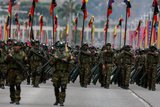Fire Scout operates across the US
Across the United States, the Navy's Fire Scout Vertical Take-Off and Landing Tactical Unmanned Aerial Vehicle took the skies, operating in four different locations ashore and afloat, Nov.18.
Over the course of one day, teams from the Navy and industry partner Northrop Grumman tested the aircraft at Webster Field, Md., Yuma Proving Ground, Ariz., aboard the USS Halyburton (FFG-40) off the coast of Jacksonville, Fla. and USS Freedom (LCS 1) at the sea range in Point Mugu, Calif.
"Flying in four locations in one day, off two classes of ships which includes our newest [LCS], marks a major milestone for our program and for Naval Aviation," said Rear Adm. Bill Shannon, Program Executive Officer for Unmanned Aviation and Strike Weapons. "This success highlights the phenomenal efforts of the entire Fire Scout team, and sets the stage for the introduction of a game-changing capability to our warfighters."
Operations began in the morning at Webster Field when the Navy/industry team conducted a functional check flight. A FCF is a routine part of the test program to determine whether the system is functioning according to established standards.
As the Fire Scout completed its flight at Webster Field, a major milestone was achieved as the unmanned helicopter took off for the first time from the Navy's Freedom class of Littoral Combat Ships. The team conducted phase one of dynamic interface testing aboard the USS Freedom, which defines the launch and recovery wind envelope aboard the ship. This is a critical step to integrating the Fire Scout on both variants of LCS.
Back on the East Coast, a pilot proficiency flight took off from the USS Halyburton. In preparation for the Fire Scout's deployment aboard the frigate early next year, newly trained operators from the Helicopter Anti-Submarine Squadron Light 42 (HSL-42) were able to get additional flight time during this operation.
"Our goal during flight tests is not only to ensure the system operates efficiently, but we also want to ensure all personnel are highly trained and qualified to operate the system when deployed, said Capt. Tim Dunigan, Fire Scout program manager. "The operators are key to successful missions."
The culmination of the day's flights ended in Yuma when a team from Northrop Grumman conducted vibration monitoring system testing. The purpose of this testing is to mature fleet procedures to perform track and balance of the rotor system.
"Extensively testing the system and monitoring its performance, makes us confident that Fire Scout will provide critical situational awareness, intelligence, surveillance, reconnaissance and targeting data to the warfighter," according to Dunigan.
Recently the Fire Scout surpassed more than 1000 flight hours since test program began in December 2006. The program is managed by the Navy and Marine Corps Multi-Mission Tactical Unmanned Systems program office (PMA-266), which is also responsible for the emerging area of Air Launched UAS.
The Fire Scout has two deployments scheduled for 2011. The system will support Intelligence, Surveillance and Reconnaissance missions aboard the USS Halyburton in the Mediterranean Sea and Horn of Africa and ground-based operations in Central Command.
Source: NAVAIR
More from Uncrewed Vehicles
-
![What's next for the Pentagon after the Replicator programme?]()
What's next for the Pentagon after the Replicator programme?
Although the Replicator initiative has made several accomplishments, there are still multiple gaps to plug across the US Department of Defense (DoD) and its services.
-
![Cummings Aerospace showcases Hellhound loitering munition designed for US Army’s LASSO programme (video)]()
Cummings Aerospace showcases Hellhound loitering munition designed for US Army’s LASSO programme (video)
Cummings Aerospace presented its turbojet-powered Hellhound loitering munition at SOF Week 2025, offering a man-portable solution aligned with the US Army’s LASSO requirements.
-
![SOF Week 2025: PDW unveils attritable FPV drone for SOF operations at scale]()
SOF Week 2025: PDW unveils attritable FPV drone for SOF operations at scale
PDW has revealed its Attritable Multirotor First Person View drone at SOF Week 2025, offering special operations forces a low-cost, rapidly deployable platform for strike and ISR missions, inspired by battlefield lessons from Ukraine.
-
![SOF Week 2025: Teledyne FLIR white paper provides guidance on reusable loitering munitions]()
SOF Week 2025: Teledyne FLIR white paper provides guidance on reusable loitering munitions
Teledyne FLIR is highlighting the emerging requirements for 'recoverable and re-usable' loitering munitions across the contemporary operating environment during this week’s SOF Week conference in Tampa, Florida.
-
![SOF Week 2025: Kraken Technology group debuts K3 Scout USV in North America]()
SOF Week 2025: Kraken Technology group debuts K3 Scout USV in North America
High-performance maritime industry player Kraken Technology Group, based in the UK, has used the SOF Week conference in Tampa, Florida this week to debut its K3 Scout uncrewed surface vessel (USV) to the North American market.
-
![Palladyne AI and Red Cat to demonstrate capabilities for autonomous drone swarms to the US military]()
Palladyne AI and Red Cat to demonstrate capabilities for autonomous drone swarms to the US military
Red Cat and Palladyne AI recently conducted a cross-platform collaborative flight involving three diverse heterogeneous drones.

























